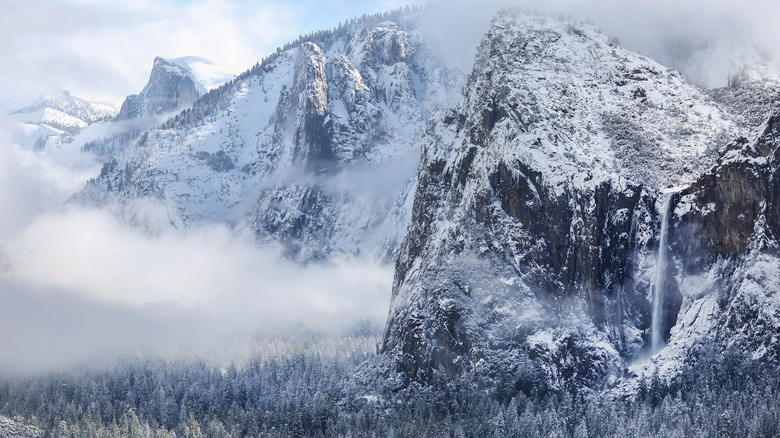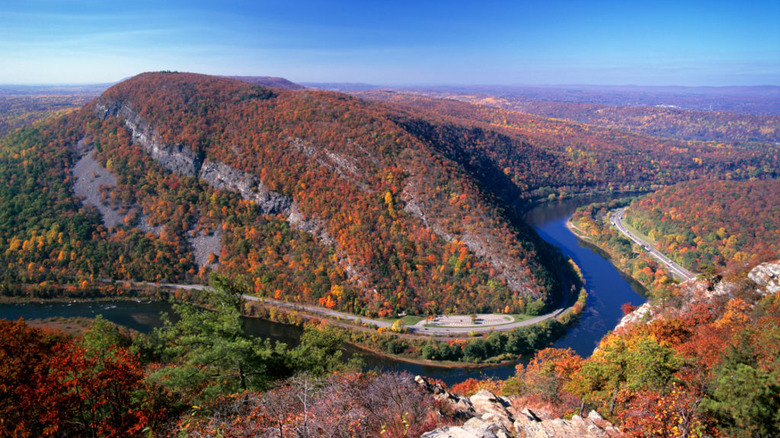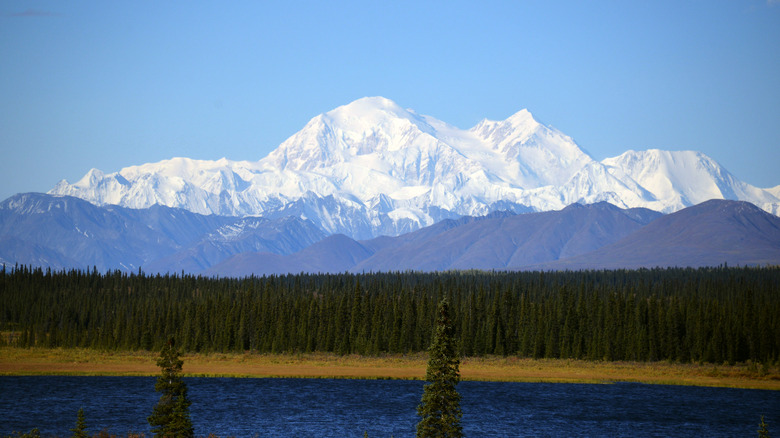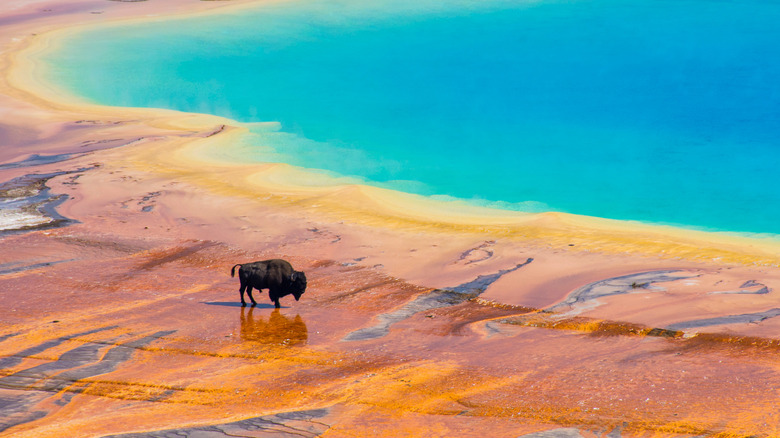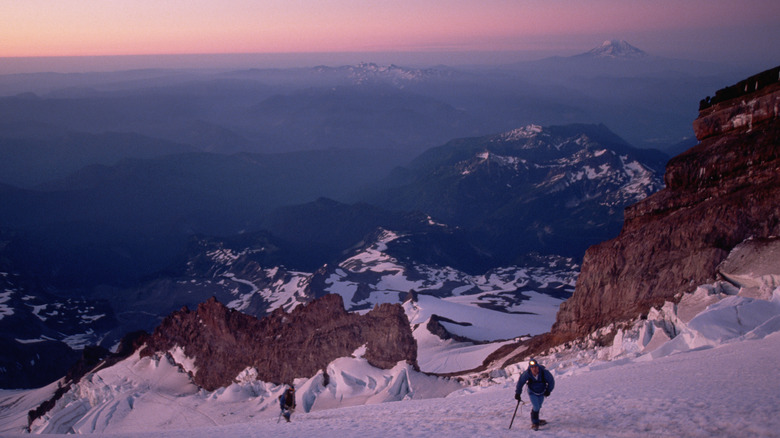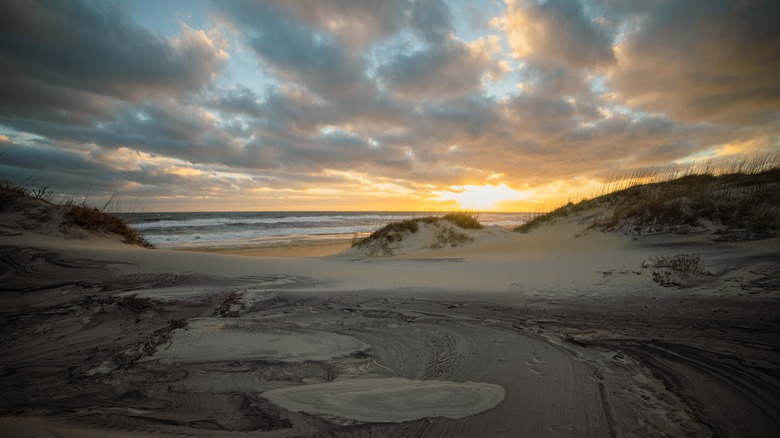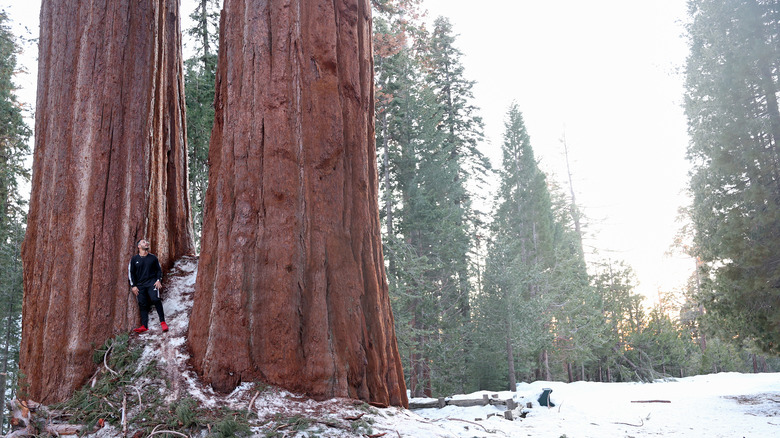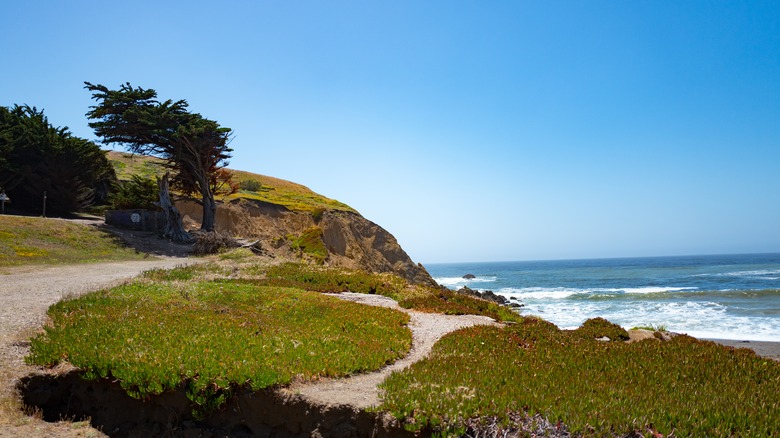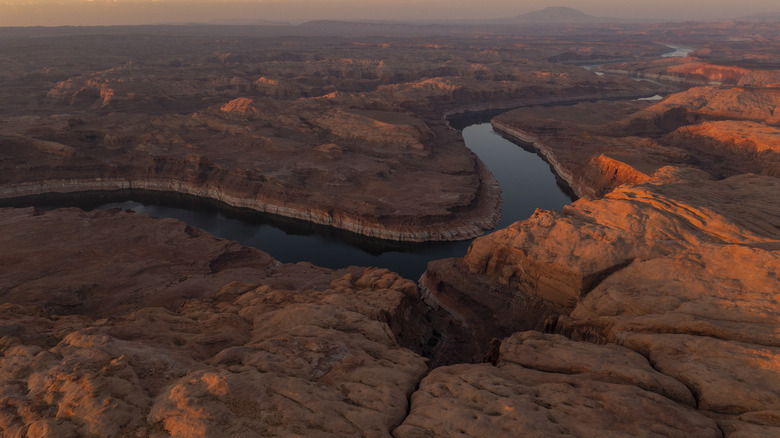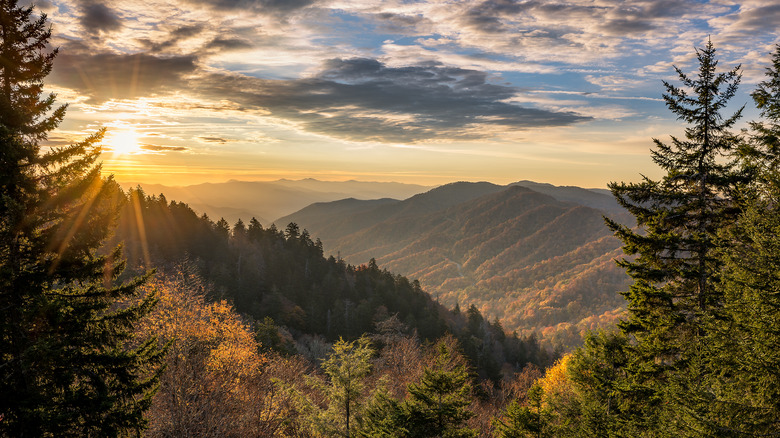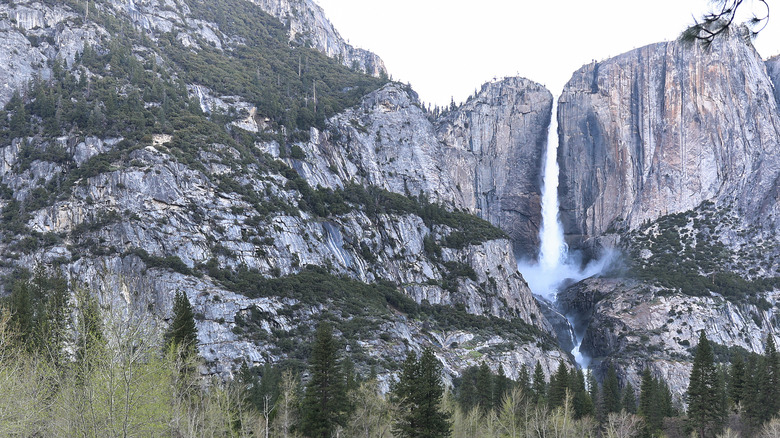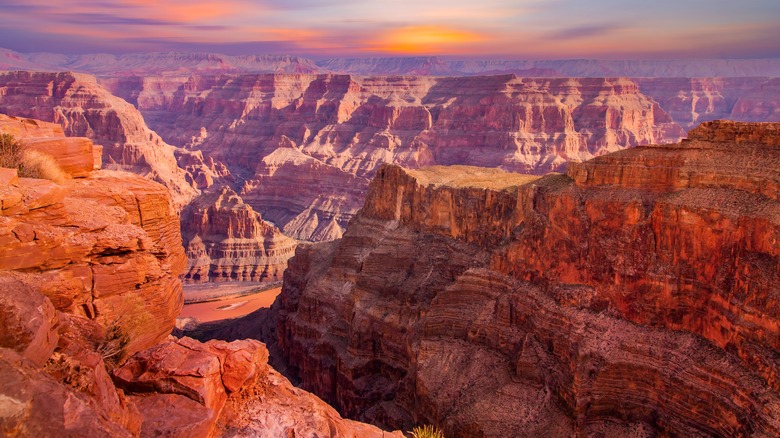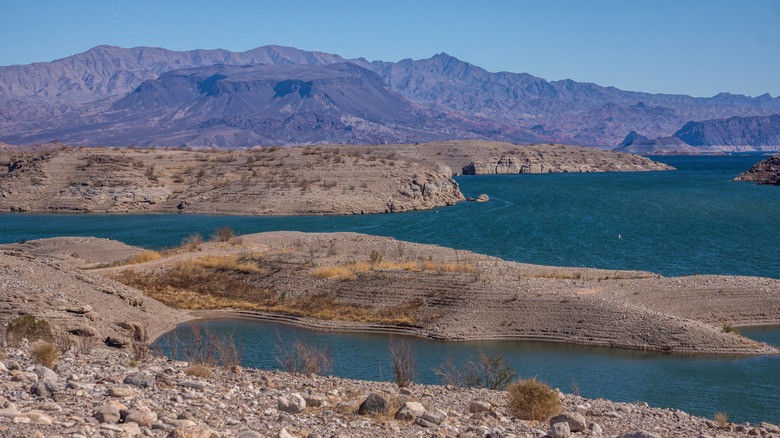The 12 Most Dangerous US National Parks
There are currently 428 national parks in the United States, and in 2022 312 million people took trips to those recreation areas to hike, birdwatch, swim, mountain climb, explore, and experience being in nature. National parks are all about preserving the natural environment, so many of them are, by definition, wilderness. While that is one of the most incredible things about these areas, it can also make them dangerous.
In general, it is very safe to visit national parks, but they are popular destinations full of rivers, cliffs, and wildlife. The leading cause of unintentional death in the parks is drowning, followed closely by motor vehicle crashes, and then deadly falls. According to Jeffrey Barnum of the National Park Service, around six people die in national parks around the country every week (via CNN). Not all parks are equally dangerous. Some parks have not had any deaths at all in the last 15 years, while others have seen hundreds of fatalities. This is partially due to the number of visitors every year, and partially because some parks have inherently a more dangerous landscape than others. We've ranked the most dangerous based on total number of deaths between 2007 and 2022.
12: Delaware Water Gap National Recreation Area
The Delaware Water Gap offers residents of New Jersey and Pennsylvania and tourists from around the world a break from chaotic everyday life by enjoying its striking views, hiking trails, boating, fishing, and swimming. However, the 40 miles of river that make Delaware Water Gap such a beautiful destination can also be dangerous. Between 2007 and 2022, 61 visitors were killed in the recreation area, and almost 60% of those people died by drowning.
Kayaking on the Delaware River might sound like a perfect weekend, but between the river's strong currents, the risk of cold water shock in the fall and winter, and the hours of serious physical labor, the river can be deadly. Even for experienced rowers, a boat or raft on the river can break or capsize. To stay safe while enjoying all the river has to offer, the National Park Service advises that everyone, regardless of their age or swimming ability, must wear a lifejacket.
11: Denali National Park and Preserve
Those visiting Denali National Park and Preserve can hike off-trail, allowing visitors to experience the Alaskan wild. Its alpine tundra and forests are home to animals like wolves, caribou, and grizzly bears, but the real draw of the park is not the wildlife -– it's the mountain. Denali is the tallest mountain peak in the U.S., and every year, climbers try to reach its 23,710-foot tall summit. Between 2007 and 2022, 63 people died in Denali National Park and Preserve. More than two-thirds of those deaths were caused by falling, cold, altitude, rock falls, or other environmental circumstances.
For the majority of the year, Denali is too cold for climbers. However, as the weather gets warmer the snow melts and deep crevasses open up. When hikers fall in, rescuers are forced to go up the mountain to try to save them, putting themselves in mortal danger as well. As Denali expert Andy Hall told the New York Post, the mountain is also extremely changeable. The weather conditions can change from ideal and mild climbing weather to extreme winds and freezing temperatures overnight, causing injuries like frostbite that could mean life or death on the mountain.
10: Yellowstone National Park
Every year, there are stories about tourists getting too close to the wildlife that makes their home in Yellowstone National Park, but the reality is that those interactions generally only lead to a few injuries per year in the park. Between 2007-2022, there were 63 deaths in the park, and only three involved animals.
The environment of Yellowstone is a bigger threat than the creatures that live there. In addition to falling or drowning, visitors have to be careful around the hot springs. In 2022, a human foot, in a shoe, had been found in a hot spring called Abyss Pool. While some might assume that severed body part had been left behind by a scavenging animal, in reality the tourist had been killed by a much more common killer in Yellowstone: the hot spring itself. As stated by USGS, in the park's hottest springs just a few seconds is enough to cause deadly burns all over the human body.
9: Mount Rainier National Park
Mount Rainier is a beloved sight in Washington State. The volcano is visible from Seattle and rivals the Space Needle as an iconic symbol of the city. As beautiful as the mountain looks, peaked with ice and snow and surrounded by wildflower meadows, Mount Rainier should not be underestimated. Between 2007-2022, 68 people died on its slopes. More than half of those deaths are known to have been caused by falls or environmental circumstances like the altitude, the cold, or rock falls. The weather at the top of Rainier is very different from the weather at the base, and dangerous snow storms can occur even in summer.
Mount Rainier is not a climb that should be undertaken lightly. While thousands of visitors to the park climb the mountain every year, reaching the summit is a serious challenge. Underprepared and inexperienced climbers put themselves, and potential rescuers, in danger. Climbers wishing to attempt to climb Mount Rainier need a climbing permit for their group and are required to pay a fee that helps to fund rescue missions on the mountain.
8: Cape Hatteras National Seashore
Cape Hatteras National Seashore is a beloved swimming and surfing destination in North Carolina. As inviting as the brilliant blue Atlantic ocean might be in the hot August sun, these waters can be unpredictable and deadly. Between 2007-2022, 70 people died at Cape Hatteras, with 80% of those deaths caused by drowning.
One reason that it can be dangerous to swim at Cape Hatteras National Park is that there are often rip currents. Rip currents are sometimes called drowning machines because they are so deadly. While they are particularly deadly to weak swimmers, they can sometimes be powerful enough to pull even the strongest swimmer so far out to sea that they are unable to get back to shore before giving in to exhaustion.
Superintendent of the National Parks of Eastern North Carolina David Hallac said in a statement (via NPS) in response to a recent drowning, "Even in the calmest conditions, swimming off the beaches of Cape Hatteras National Seashore is much more difficult than swimming in a pool or lake and only the most experienced should consider entering the water."
7: Sequoia and Kings Canyon National Parks
Sequoia and Kings Canyon National Parks are popular with avid hikers, mountain climbers, and tourists of all kinds looking to experience some of California's natural beauty. As incredible as the views from Mount Russell are, going mountain climbing always includes some risk. Between 2007-2022, there were a total of 86 reported deaths in the parks, and around a third of them were due to deadly falls.
These are popular parks, but the high number of deaths just isn't just due to the large number of annual visitors. As calculated by Backpacker, Sequoia and Kings Canyon have 4.4 deaths per every million visits to the parks, which is higher than the vast majority of national parks. After a hiker tragically fell from the summit ridge of Mount Russell in 2021, the National Parks Service issued a statement to potential climbers, warning, "There is never any guarantee that rescuers will be able to reach you quickly. Understand your own limits, take care of the people in your party, and always be prepared to turn back."
6: Golden Gate Recreation Area
The Golden Gate Recreation Area is known for its history, biodiversity, and coastline. Visitors can learn about the Indigenous peoples that used to live in the region, see the towering redwoods of Muir Woods, visit the only UNESCO biosphere reserve that includes seashore and borders a city, and visit the white sands of Stinson Beach. With 92 unintentional deaths between 2007-2022, this park is easily one of the deadliest in the country, but it may actually be safer than it seems. This high number of deaths is mostly due to the absolutely massive number of visitors to this natural oasis just outside of bustling San Francisco, California. As detailed in an analysis by the law firm BSBR, out of every 10 million visits to the park, less than five end in death.
That isn't to say that no dangers are lurking in The Golden Gate Recreation Area. One potential threat to visitors is the beaches. Only Stinson Beach is open for swimming, and many of the park's other tempting beaches are dangerous. There are rip currents which can be extremely dangerous to even powerful swimmers. In some places, there may even be dangers for those just walking on the beach. Sneaker waves may suddenly crash on the beach, pulling in anyone in their path.
5: Glen Canyon National Recreation Area
As strange as it seems for a park primarily made up of desert, almost 40% of the 113 deaths in Glen Canyon National Recreation Area between 2007-2022 were drownings. This is because Glen Canyon is home to the beautiful Lake Powell, where the Colorado River meets the Glen Canyon Dam, and its unique desert landscape is cut by river corridors. Despite the hazards, this park is a favorite of campers, boaters, and swimmers.
A study of deaths in Glen Canyon published in the Journal of Travel Medicine found that most of the people who were killed in the park were boating or swimming. There are no lifeguards in the park and at none of the beaches, and although it isn't prohibited, swimming is considered an "at your own risk" activity. The National Park Service highly recommends that both swimmers and boaters wear lifejackets at all times. Another hazard is cliff jumping, which accounted for 5% of deaths in the study. It has been a popular activity at Lake Powell for a long time, but it is prohibited because it is extremely dangerous. As noted by the National Park Service, jumping from 50 feet above the lake means striking the surface at 40 miles per hour.
4: Great Smoky Mountains National Park
The Great Smoky Mountains National Park, primarily made up of mountains and forests in North Carolina and Tennessee, has more visitors than any other national park. Although the vast majority of those visits are safe, between 2007-2022, 113 people were killed at Great Smoky Mountains National Park. That is not a new phenomenon. As detailed in an interview with Knox News, researcher David Brill detailed the hundreds of deaths that have occurred there since 1931.
Even though the park is famous for its hiking, the majority of deaths there have actually been automobile accidents. Many of these take place on a scenic road known as The Spur, which runs through the park. Another dangerous area in the park is known as The Sinks. At The Sinks, a river that runs down from the mountain winds around enormous boulders, creating small pools with a view of a magnificent waterfall in the background. Unsurprisingly, these pools are popular swimming spots but can also be deadly. According to Brill, at least 59 people have drowned in the park, many of them at The Sinks.
3: Yosemite National Park
California's famous Yosemite National Park is an extremely popular destination for hikers, climbers, and tourists of all kinds due to its impressive cliffs and waterfalls, but as detailed in a report from the California law firm Roberts & Spiegel based on data from the National Park Service, this unique landscape can also be extremely dangerous. Between 2007-2022, there were a devastating 146 deaths at Yosemite, with an additional 17 deaths in 2023. This is slightly above average, but there are around 13 or 14 deaths in the park every year.
Deadly falls are the most common way to die in Yosemite National Park. Tragically, these deaths are sometimes caused by people putting themselves into risky situations in an attempt to get the perfect photograph. The park is extremely beautiful, and it can be tempting to pose for a shot by cliff's edges and waterfalls, but in the past hikers have been killed trying to get the shot.
2: Grand Canyon National Park
The Grand Canyon is certainly one of the most iconic destinations in the U.S. While millions of people check this incredible Arizona spot off their bucket list every year, for an unlucky dozen or so people each year, it can be deadly. Between 2007-2022, there were a staggering 149 unintentional deaths in Grand Canyon National Park.
The most obvious risk is falling, both from the ledge and inside the canyon itself, but there are other natural dangers as well. As noted in a report from the Arizona law firm Hastings & Hastings, the high temperatures in the canyon -– sometimes as high as 120 degrees Fahrenheit -– can quickly cause dehydration. On the other hand at high elevations, snow storms can be deadly.
Surprisingly, the most common cause of death in the Grand Canyon National Park has nothing to do with the natural world. In the park's history, there have been 379 deaths due to plane and helicopter crashes. In both 1956 and 1986, two aircraft struck each other over the canyon. Tragically, these planes and helicopters either diverted from their course to fly over the canyon or set out specifically for the view, leading to deadly crashes.
1: Lake Mead National Recreation Area
By far, the most deaths in national parks have occurred in Nevada's Lake Mead Recreation Area, which had a horrific 252 deaths between 2007-2022, and an additional 19 more before August of 2023. While the park has developed a reputation as being America's deadliest National Park, it is still a popular swimming destination for Las Vegas locals and tourists alike. In recent years, the park has seen between 5.6 and 7.6 million visits annually. The massive amount of visitors is certainly partially responsible for the unusually high number of deaths — but visitors to Lake Mead are not dying of natural causes. Around 40% of people who died at Lake Mead drowned.
In an interview with KTNV, National Park Service public information officer John Haynes stated that visitors to Lake Mead should be wearing life jackets, because the weather can be unpredictable: "You think you're jumping out of your boat for a quick swim ... But because of high winds, all of a sudden, your boat is drifting away and you're stuck in the middle of the lake."
Our methodology
There are many different ways to calculate what is the most dangerous national park. This article's rankings are based on the total number of deaths at each park between 2007-2022, as reported by the National Park Service in response to a Freedom of Information Act request.
Although the total number of visitors to each park is sometimes included for context within this article, this ranking does not reflect the statistical likelihood of dying in any particular park –- simply the number of people who have died. According to a report by the law firm PSBR, also based on data from the National Park Service, the national park with the highest chance of any individual visitor dying is Washington State's mountainous North Cascades National Park. However, between 2007-2022, there were only 20 deaths there, so it is not included in this ranking.
Due to a lack of data, this ranking does not include non-fatal injuries. As quoted by NBC News, North Cascades National Park spokeswoman Cynthia Hernandez stated park visitors are often injured or have close calls while exploring national parks, but they typically do not report them. Also excluded from our rankings are what the National Park Service refers to as "intentional deaths," or those who died by suicide.
